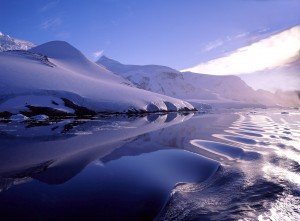South African ecologist Professor Steven L Chown wants to see New Zealand seek special marine protection status for the whole of the Ross Sea.
 NZ research voyages in 2001, 2004 and 2008 gathered data for a scientific case for special United Nations protection for the marine ‘oasis’ around the Balleny Islands, a biodiversity hotspot seen as critical to the healthy functioning of the larger Ross Sea ecosystem — but Prof Chown sees potential for protecting the whole Ross Sea.
NZ research voyages in 2001, 2004 and 2008 gathered data for a scientific case for special United Nations protection for the marine ‘oasis’ around the Balleny Islands, a biodiversity hotspot seen as critical to the healthy functioning of the larger Ross Sea ecosystem — but Prof Chown sees potential for protecting the whole Ross Sea.
Though the Ross Sea makes up just 2 percent of the Southern Ocean, some scientists regard it as the last intact marine ecosystem left on Earth.
In 2006, New Zealand proposed a strategy for future management of marine living resources and biodiversity of the Ross Sea which allowed for ‘well managed sustainable harvesting’ but Prof Chown told the Science Media Centre in Wellington that the fishing should stop.
The director of the DST-NRF Centre of Excellence for Invasion Biology at South Africa’s Stellenbosch University, Prof Chown has worked in the Antarctic region for more than 25 years,
Here is an excerpt of an interview he gave after presenting a lecture, Lion Griefs in the Shade, Global Change Biology in the Antarctic, at Victoria University on September 8, focused on environmental change and its consequences in the Antarctic, as part of the annual S T Lee Lecture Series in Antarctic Studies.
As a key gateway to the Antarctic, should New Zealand be doing more to protect the continent’s biosecurity?
“In terms of biosecurity, New Zealand is actually at the top of the game among Antarctic Treaty nations — they have led the way in showing the rest of the world how to deal with biosecurity matters. There have been workshops in Christchurch involving Antarctica NZ and Gateway Antarctica. There are always concerns, but NZ is one of the nations that is dealing with them very effectively”.
Is there any scope for NZ’s approach to biosecurity to be used as a model?
“Absolutely – you’re so good at it. As an island state, you understand about biosecurity”.
In Antarctic tourism, is a licencing scheme sufficient to ensure that tourism operators keep to protocols designed to protect Antarctic ecosystems from invasive organisms?
“The International Association of Antarctica Tour Operators (IAATO) is very careful. With increasing numbers of ships and tourists, there is a rising level of risk, but the tourists seem to have — in some data that we haven’t published yet — a lower number of plant seeds on them than scientific personnel (outside of research stations). Of course, there are few scientific personnel, so you have to multiply the seed ‘burden’ by the number of people involved.
“The main problems lie with tourism operators outside IAATO, who don’t subscribe to Antarctic biosecurity protocols. But the problems don’t only lie with tourists. Research bases bring a lot of infrastructure with them, and someone has to think carefully about about both sets of activities.
“To a large extent, the (Treaty secretariat’s) Committee for Environmental Protection (CEP) is thinking this way, but the Treaty is not mandatory. You encourage everyone to do things, and I think that we need more encouragement”.
The layman’s perception of the Antarctic environment is one of snow and ice – how complex are the ecosystems potentially at risk from invasive species?
“It’s remarkably complicated everywhere. Though most of the continent still has temperatures that are too low to be affected by visible organisms, the impact of mico-organisms from temperate areas is much more difficult to understand. On the (warmer) Antarctic Peninsula, and on sub-Antarctic islands there are concerns. Though these environments are dynamic — there is natural change — one major challenge is how we attribute the observed changes to natural causes or introduced species as climates change, and warm up and make things more environmentally-conducive to species from elsewhere. That’s going to be particularly problematic”.
What scope is there for the Southern Ocean around Antarctica to be given greater protection from human actions such as fishing?
“The whole Southern Ocean is already being exploited — there is exploitation of toothfish. But (New Zealand’s) Ross Sea area really could serve as an example. It hasn’t been heavily fished yet and its fish stocks are in good order.
“I think that is an area that could really be set aside as an ecosystem that is free of direct human intervention as is possible, given our global changes to the environment. I really think that would be a good thing to aim for. Of course, there is a fishery industry there, and by all accounts it’s worth about $US50 million or so — that’s really not a large amount of money.
“Wouldn’t it be good, if maybe NZ said: `We have to do this’ and again led the way? You have a long record of leading the way on issues such as human rights, so why not lead the way here?”
There are biodiversity ‘hotspots’ such as the Balleny Islands that could be protected?
“There’s all sorts of stuff coming out of the Circum-Antarctic Census of Marine Life – for some benthic organisms the Antarctic is incredibly rich. In some parts of the world we’ve fished everything virtually to a standstill: we’ve trawled the bottom of the ocean until it looks like destroyed rainforest. Elsewhere we also need conservation of ecosystems, but wouldn’t it be great if we said: ‘We’re going to set aside this whole system’?”